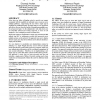727 search results - page 130 / 146 » A theoretical framework for multiple neural network systems |
SIGUCCS
2003
ACM
14 years 27 days ago
2003
ACM
It has been our effort at Ringling school to provide our campus community with the capability to uniformly access resources across multiple platforms. Empowering the user with a s...
MOBICOM
2012
ACM
11 years 10 months ago
2012
ACM
GPS is one of the most widely used wireless systems. A GPS receiver has to lock on the satellite signals to calculate its position. The process of locking on the satellites is qui...
IPSN
2010
Springer
14 years 2 months ago
2010
Springer
Current data collection protocols for wireless sensor networks are mostly based on quasi-static minimum-cost routing trees. We consider an alternative, highly-agile approach calle...
GLOBECOM
2009
IEEE
14 years 2 months ago
2009
IEEE
—A key technology in cooperative communications is distributed space-time coding (DSTC) which achieves spatial diversity gain from multiple relays. A novel DSTC, called randomize...
VR
2002
IEEE
14 years 16 days ago
2002
IEEE
In this paper, we introduce DLoVe, a new paradigm for designing and implementing distributed and nondistributed virtual reality applications, using one-way constraints. DLoVe allo...

